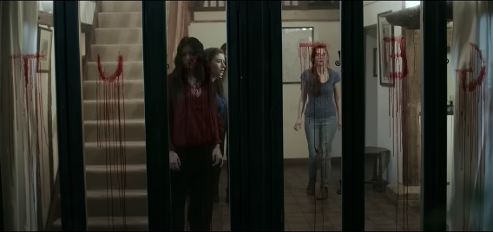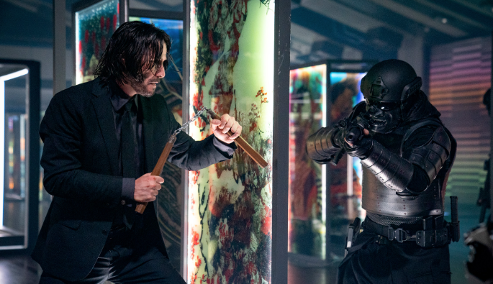
Cast: Craig David Dowsett, Chris Cordell, Amber Doig-Thorne, Natasha Tosini, Maria Taylor
Director: Rhys Frake-Waterfield
89 mins
“I think something’s wrong with Piglet! He just killed my wife!” In two sentences, Christopher Robin (Nikolai Leon) manages to silence anyone who complains that we don’t produce iconic film quotes any more while pretty much summarising everything that’s worth knowing about Winnie the Pooh: Blood and Honey. It’s Pooh and Piglet, but they’re evil! We all know the story of Christopher Robin and his anthropomorphic animal friends who play in the Hundred Acre Wood. But A.A. Milne’s beloved children’s books never address what happens after Christopher inevitably grows up. Rhys Frake-Waterfield’s micro-budget slasher flick attempts to fill that gap in the mythology, complete with a cheaply achieved animated opening sequence revealing that Pooh and Piglet began starving to death after Christopher left for medical college and eventually made the decision to kill and eat Eeyore to stay alive. But it’s very hard to commit just one murder, and Pooh (Craig David Dowsett) and Piglet (Chris Cordell) have gradually turned into cold-blooded killers who take their feelings of abandonment out on any humans unlucky enough to visit the Hundred Acre Wood. When a grown-up Christopher Robin brings his new wife back to meet his former childhood friends, Pooh and Piglet will stop at nothing to commit him to a painful death. Even if that means killing the five young women having a holiday break at a cabin in the woods who just happen to be in their way.
Winnie the Pooh: Blood and Honey feels like a throwback to a simpler era of filmmaking. Not an era where cinema was better — because it’s not particularly good — but a time when a film could be produced, marketed, and turn a profit just by promising audiences an image they hadn’t seen before. In the same way old women-in-prison movies would blatantly advertise a nude shower scene and knock-off slasher flicks would list the types of dismemberment that they showed on their posters, Winnie the Pooh: Blood and Honey makes no attempt to hide its simple value proposition. You’re paying to see Winnie the Pooh and Piglet brutally murder a bunch of people, so to hell with the story! The benefit of setting a low bar is that it’s easy to clear, and nobody can accuse Winnie the Pooh: Blood and Honey of failing on those promises. The film punches above its weight on craftsmanship, with decadently gory strangulations and decapitations that could have been ripped from a much more expensive production. Also, it would be review malpractice of me not to report that blood and honey are hardly the only two of Pooh’s bodily fluids that we’re forced to look at. Don’t say you weren’t warned. The trade-off is that the script makes an enormous amount of what can charitably be described as “narrative compromises” to make all of the violence fit into a world that feels remotely coherent. We’re told early on that Pooh and Piglet became killers because they were starving after Christopher Robin stopped sneaking them food from his kitchen — fair enough, we all have to eat — but that doesn’t explain why they would go through all the trouble of equipping their forest hideaway with a series of complicated torture devices, let alone where they could have acquired the skills and materials to do so. Pooh’s ability to drive cars is equally puzzling, even if it results in some splendidly gory kills.
All of these plot holes — combined with the fact that Pooh and Piglet have the bodies of grown men who never even attempt to mimic animal mannerisms — add to the sensation that this is just a generic slasher outing with Pooh masks slapped on it. Director Frake-Waterfield seems determined to shock audiences, yet the lack of effort is considerably more offensive than the blasphemy. But regardless of all this, it’s highly amusing that something as utterly imbecilic as Winnie the Pooh: Blood and Honey is a film where Pooh uses Eeyore’s severed tail to whip a shirtless Christopher Robin like a dominatrix. The absurdity of the situation isn’t lost on the film’s production team. Associate producer Vince Knight apparently found himself in the rare position of trying to dampen down the hype surrounding his film. “Don’t expect too much,” he said with a laugh. “We spent a lot of time working on it but not a lot of time actually shooting it.” It remains to be seen if the “Disney characters, but scary” genre has any staying power beyond the initial novelty factor, but Frake-Waterfield and his team are certainly betting on it. A sequel to this is already in the works and which Knight teased could include Tigger, who didn’t enter the public domain in time to make the first film, and they’re also developing horror takes on Bambi and Peter Pan. Maybe after a century of Disney-fication, fans are ready to see their favourite childhood characters become freaks.

Cast: Keanu Reeves, Laurence Fishburne, Bill Skarsgård, Donnie Yen, Hiroyuki Sanada, Rina Sawayama, Ian McShane, Lance Reddick, Scott Adkins, Marko Zaror
Director: Chad Stahelski
149 mins
Bringing the best re-invention of gunplay to the screen since John Woo’s Hong Kong films, with a melding of tactical ingenuity and visual flair, John Wick: Chapter 4’s slightly convoluted story has found new ways to introduce amazing action sequences that consistently top what came before. Not only does JWC4 continue this tradition, but it’s arguably the best of the series. It doesn’t have the simplicity or emotional core of the first, but that’s overshadowed by non-stop spectacle that defies expectations to bring viewers some of the most exciting action in an American film for quite some considerable time. Following his being shot off the roof of The Continental Hotel by his friend Winston (Ian McShane), John Wick (Keanu Reeves) has gone underground — literally, as he resides in the sewer under the protection of the Bowery King (Laurence Fishburne), patching up his wounds and training to resume his vengeance on the High Table. When John begins to enact his revenge, the Marquis (Bill Skarsgård) enlists multiple assassins to take him out once and for all, including retired hitman Caine (Donnie Yen), a blind warrior who is tasked with tracking and killing his former friend. Despite a nearly three-hour running time that whizzes by, thanks in no small part to director Chad Stahelski’s excellent command of pacing, sequence after sequence unfolds in dynamic new ways that never feel repetitive but instead constantly inventive through outstanding stunt co-ordination. It never feels like sensory overload, either, thanks to a vibrant script from Shay Hatten and Michael Finch, which introduces quieter moments in between the explosive scenes. These calms before the storm are used to ratchet up the stakes and build characterisation for the latest members of the roster, particularly Skarsgård and Yen.
Yen, Hiroyuki Sanada, Scott Adkins and Marko Zaror are all top-notch action performers who manage to mesmerise with their physical prowess and command of the screen, allied to the fact that Adkins can be as nimble and impressive while decked out in a fat suit. This is a true testament to his skillset, improved only by the fact that he’s genuinely menacing rather than an obese joke. Performer Rina Sawayama is also very good, in this, her first action outing. She is superb at carrying out the complex choreography in a fluid way that suggests she’s been doing it for decades. At the centre of it all however, is Keanu Reeves. Once a Hollywood byline of an actor, it seems that producers have finally come around to the earnest approach of his work. He doesn’t have pages of monologue, but he carries this film on his determined sincerity. The world of John Wick is a hyperreality that often defies credulity and even physics, but it’s grounded in the genuine sense of pain and anger within John Wick that Reeves conveys. Wick had his chance at redemption but chose to dive back into a life of violence, with all the bloodshed and tragedy coming from his inability to deny his destructive nature. He’s a lonely and tragic figure, but a noble one who is seeking to emerge from his dark world for the second time… even if it seems like he will be eternally drawn back to it. Chapter 4 doesn’t have the emotional immediacy of the initial outing, but the tangible feeling of loss and righteous anger has been replaced by a constant movement to stay one step ahead of disaster. Wick is reacting to what has been done to him, as opposed to what was taken from him. That lack of poignancy robs the film of some of its depth and impact, but there are still enough rousing sequences to distract from such a disconnection. It would be hard to outdo the loss of a simpler life as the main impetus this late in the franchise, but more call-backs to the pain caused by Wick’s torching of worlds would have been welcomed. The John Wick franchise is about loss. How to cope with what was taken, how we are the architects of our own pain and what is left behind when everything is stripped away. Certainly it’s dressed up with incredible and dazzling fight choreography, but at its heart, the franchise is about finding out who we are after we’ve lost everything. It’s still a thematic presence in the storytelling that it pulls other characters beyond the titular protagonist into the discussion of what remains - and whatever the film lacks in emotional resonance it more than makes up for in amazing spectacle with a mix of inventive scenarios that showcase the playful side of these impressively original action sequences. John Wick: Chapter 4 solidifies its reign as a tremendously entertaining film that succeeds on every level.